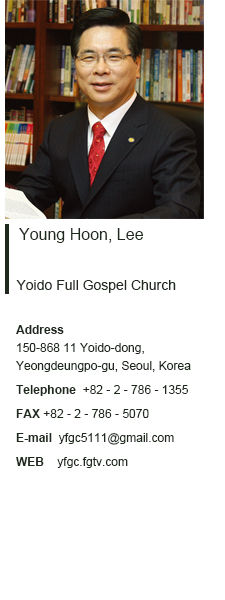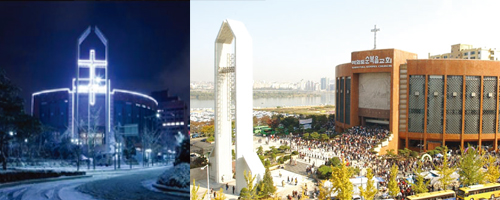
|
Yoido Full Gospel Church (hereafter YFGC) began with a makeshift tent church with five members
on the suburban area of Seoul in 1958, and grew as the largest church in the world with the
membership of 780,000 as of May, 2008 in fifty years. In the year of 2008, there had been a
transition in the leadership of the church when its founder Rev. Yonggi Cho retired from his
fifty-year ministry as the senior pastor of the church. Since Rev. Young-hoon Lee was elected and
inaugurated as the new senior pastor of the church, twenty satellite churches of the church around
the Great metropolitan area of Seoul?or Pastor Cho¡¯s ¡°disciple churches¡±?had become gradually
independent from YFGC with 360,000 church members, and their full independence was granted
to them in January 2011. Nevertheless, YFGC has continuously accommodated new church
members so that the number of its congregation reaches over 480, 000 as of January, 2013.
01 The History of the Growth of YFGC
YFGC¡¯s 50 years and more history may be divided into three periods. The first is the Pioneering
Period of Daejodong Tent Church (1958-1961). Pastor Cho, then a fresh graduate from Full Gospel
Theological Seminary, planted a church by raising a tent in a sesame field in Daejodong, a slum
area in Seoul in May 18, 1958. The revival of the tent church was possible because of Pastor Cho¡¯s
Pentecostal ministry. As church members received the Holy Spirit and are healed from their illness,
and the blessing was present in their life, more new members rushed into the church. In 1961,
when the tent became too small to accommodate the increased members of the church, Pastor
Cho moved the location into Seodaemun, which was not far from Daejodong and was closer to the
downtown of Seoul.
The second is the Developing Period of Seodaemun Full Gospel Central Church (1961-1973). Pastor
Cho established the Full Gospel Central Revival Center in Seodaemun (renamed as the Full Gospel
Central Church in May, 1962) in October, 1961. Many incidents of healing, deliverance, signs and
wonders appeared in Seodaemun Church just as in Daejodong. Such a powerful move of the Holy
Spirit led to church growth. Church membership reached 8,000 in 1968, the tenth year after the
planting of the church. Seodaemun church began to introduce an organizational system for a
continual growth. Pastor Cho made cell organizations, which combine several families according to
the residential place of all church members and organized cell leaders among laymen. Such cell organizations are still playing
a role of basic organizations today. The Seodaemun period was the time when the rapid growth of the church was made in the
combination of dynamic and stable care ministry with the Pentecostal movement through cell groups.
The third is the Expanding Period (1973-Present). Seodaemun Full Gospel Central Church decided to move to Yoido to accommodate
the increasing church members in 1968. In 1985, YFGC¡¯s membership reached 500,000. Around that time, YFGC built
20 campuses on the outskirts of Seoul as well as in its surrounding cities and equip them with satellite systems for simultaneous
worship service. When Pastor Cho retired in 2008, YFGC had 780,000 members. After Young-hoon Lee elected the
second senior pastor of YFGC in 2008, he made the campuses, or ¡°disciple churches¡± as they are called at YFGC independent.
This was approved of by the Church Steering Committee. It was a very peaceful process, although it decreased the membership
of YFGC to 430,000. However, putting priority on evangelism as well as events like new life evangelical festival gave YFGC
another momentum for growth. YFGC membership began to grow again and reached 480,000.
02 The Features of the Ministry of YFGC
The ministries of YFGC comprehend the works of the personal, individual salvation of the souls at home and abroad, of the
training and education for the spiritual experience and maturity of the church members, and of the missions on the social
dimension. Through the message of the holistic salvation, prayer movement, cell system, education for lay believers, it
consistently conveys the gospel of the eternal life to the people in the world and to encourage the church members to have the
consistent spiritual experience and to go forward to the spiritual maturity. Furthermore, it performs missions on the social
dimension with the activities of diverse services and sharing.
2-1 Declaration of the full gospel message of the holistic salvation: The distinguishing elements of the Holy Spirit movement
of YFGC are salvation of the spirit, faith centered on the word of God, experience of the Holy Spirit, and world evangelization.
These are supported by the message of the holistic salvation of the fivefold gospel and the threefold blessing. The fivefold
gospel consists of the gospel of salvation, the gospel of the fullness of the Holy Spirit, the gospel of divine healing, the gospel
of blessing, and the gospel of the Second Coming of Jesus Christ. The threefold blessing is based on 3 John 2 and describes
the blessing that Christians receive by the work of the cross of Jesus Christ.
2-2 Prayer movement: One of the most emphases in YFGC is praying. YFGC has the time of praying with a cry in all services.
Especially, the service on Wednesday and the prayer meeting on Friday night has the time of praying with a cry for 20 minutes
and more with the laying on of hands in prayer by the pastors. Each large section of parish goes to
the prayer mountain every month to hold the prayer meeting for the fullness of the Holy Spirit and
concentrates on praying. This earnest prayer movement of YFGC operates as the channel of the
power of the Holy Spirit, which gives a challenge to many churches in the world whose passion of
praying cools down and whose time of praying is not as much long and enthusiastic as the time of
praising.
2-3 Educational activities for lay people: YFGC has the systematic educational programs for the lay
people and operates them. The Bible study programs are being operated by levels with the length
of one year each level. Besides, diverse spiritual training programs with the length of short or
medium term are prepared and conducted for the development of the lay people¡¯s spiritual maturity.
2-4 Overseas Mission: YFGC has performed the mission of global evangelism based on the faith of
the second coming of Jesus Christ. YFGC became the missionary country in support of numerous
missionary societies aiming at missionary work targeting all continents and nations around the
world. Currently, YFGC has 703 missionaries who are dispatched to nations around the world, and
runs seven Theological Seminaries and one University.
2-5 Diverse activities of social services and sharing: YFGC¡¯s mission engagement has always
included social activities. YFGC concentrates on the reinforcement of the social service by complementing
the social dimension to the teaching of the holistic salvation. Rev. Young-hoon Lee takes
precedence of the enforcement of the budget of relief expenses most primarily since proceeding to
his post as a senior pastor of YFGC.
1 Setting social agenda and raising Christian leaders:
YFGC founded The Kukmin Ilbo Daily in 1988
for the purpose of setting social agenda from the Christian worldview. This is one of the most
conspicuous projects YFGC initiated for social salvation. The Kukmin Ilbo Daily has cooperated with
various NGOs in its e�orts for social transformation as well as been active in raising funds to help
disaster areas in Korea and abroad. Another aspect of YFGC¡¯s social involvement is education. YFGC
contributes to raising Christian leaders for the 21st century through Hansei University, Full Gospel
Youngsan Theological 30 Seminary, and Bethesda Christian University (California, U.S.A.).
2 Social welfare project:
YFGC established Elim Welfare Town in Gunpo-city, Gyeonggi-do in 1988, which is the largest welfare
facility in Asia and began to implement the outreach program for the poor youth, and the elderly person with no one to rely on.
YFGC has served the hungry neighbors by transcending borders, religions and ideologies through the UN a�liated International
NGO named ¡°Good People¡± since 1999. The projects such as a medical clinic for children, health care through medical service
corps, child protection through the a�liation with a local center for children and the support programs for senior citizens who
live alone, the handicapped and the child heads of household are performed in the domestic area. YFGC began to do surgery
support business for the children with heart disease free of charge in 1984. In 1982, it established the Movement Headquarters
for Sharing, and delivered the necessities to orphanages, nursing homes, urban slums, rural churches, and Sorokdo (a facility
for Hansen¡¯s Disease victims) across the nation. In 2003, it opened the Full Gospel Medical Center and carried out medical
services to villages without doctors as well as foreign workers, the handicapped, rural churches. Besides these works, Free Civic
College was established for helping the successful settlement of North Korean refugees. Currently, there are 15 convenience
stores, which are run by North Korean refugees under the help of Free Civic College. Meanwhile, the footings of missionary work
has been solidified through the support of educational facilities, drinking water, environmental amelioration, medical service
and the establishment of hospitals towards the third world at abroad.
3 The support for North Korea for humanitarian reasons and the establishment of infrastructure in preparation for reunification:
YFGC has developed the support projects for North Koreans through Good People such as sending of corn seeds and
fertilizers, meals for children, roasted and ground grains, and tuberculosis medicine. In 2007, Yonggi Cho Cardiologist Hospital
was constructed in in Pyongyang for the treatment of children with heart disease. This can be the basis of reunification of Korea,
going beyond the economic support in simple humanitarian dimension.

|



